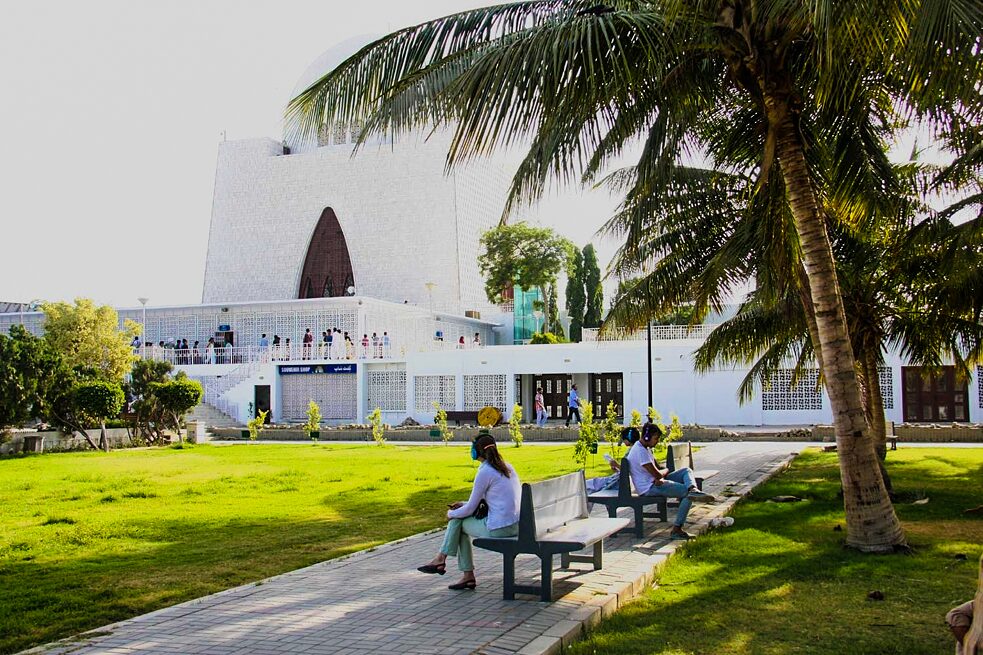Audiowalk-Stories of Displacement

Commissioned by HAU Hebbel am Ufer. Production: Sonya Schönberger & Shahana Rajani in collaboration with Goethe-Institut Pakistan.
In this audio walk the Pakistani and German "displacement" stories were juxtaposed and became audible. Despite the historical and regional differences "I would always dream of my house – stories of displacement" stresses the exchanging and sharing of experiences and memories. The Audio Walk is an attempt to speak about the similarities we find in humankind.
The Audio Walk took place simultaneously in Berlin and Karachi. The audio files were in English, German and Urdu. In Berlin, the Audiowalk took place in HAU 2 with a recommended route towards the Elise-Tilse Park, the park on the site of the former Anhalter Bahnhof. In Karachi the Audiowalk took place at Quaid's Mazar, which used to be the site for the largest partition refugee colony in the city called Quaidabad.
1. Introduction about yourself, background.
Sonya: My name is Sonya Schönberger, I live and work as an artist and theatre maker in Berlin, Germany. My educational background lies in Social Anthropology and Visual Art. Interviews and conversations are usually the base for developing my works that can be performances, audio pieces, installations or photographs (www.sonyaschoenberger.de).
Shahana: I am an artist and curator working and living in Karachi. My practice is research based and invested in experimenting with new forms of art making and knowledge production in public spaces. I am also involved with the Karachi Art Anti-University, which I co-founded last year as an attempt to politicise art education in Pakistan and collectively explore new radical pedagogies.
2. Tell us about your project.
Shahana and Sonya: 'I would always dream of my house - stories of displacement' is a collaborative project that I and Sonya worked on together. It is an hour-long audio walk, which narrates and interweaves stories of displacement from World War II and the Partition of India. The audio walk took place simultaneously in Karachi and Berlin from 13-15 May 2016.
3. How did you both come up with the idea of doing the project together across Karachi and Berlin?
Sonya: Last year, I was invited for a show at IVS Gallery in Karachi. During my stay, I was also introduced to Shahana. Long before we had met, we already focused on historical events in our artistic work. We were both interested in the escape and expulsion stories of our grandparents’ generation, to make visible how experiences of war continue to cast their shadow on the present. Within our conversations about our interest and practice, we easily touched common ground and decided we should collaborate.
Shahana: While Sonya interviewed people in Germany and the USA, who lived through World War II, the Holocaust and their aftermath, I was collecting stories of refugees who had fled their homes during the Partition of India. While both of us were already collecting these oral narratives to document and understand experiences of dislocation and dispossession, what really brought us together was our common interest in highlighting not just the historical dimension of war and displacement, but its contemporary resonance and urgency.
4. What was the main objective of the project also the keyword to describe it?
Shahana: With I would always dream of my house, we hoped to link past histories with present situations in order to apprehend these modes of dispossession as a fundamental part of our existence. Refugee crises in general are routinely understood as only 'temporary'. For instance, Partition is often imagined as a momentary rupture, we assume its 20 million refugees to have been restored to a settled existence. However, our collected stories refute this assumption. Our project shows that displacement is a long and continuing process - for many, 70 years later, the violence of displacement is still on going.
Sonya: We are also always interested in looking at these stories from the point of view of our own generation. What does this have to do with our lives, who are we looking at the lineage of people and why are we the way we are.
5. Tell us about the support from the Goethe-Institut, how helpful was it and how did you benefit?
Through the generous support of Goethe-Insitut Pakistan, we had the opportunity to develop and materialize our project, which enabled a sharing of experiences and histories across Pakistan and Germany. The Berlin side of the project was funded by HAU Hebbel am Ufer.
6. Challenges you faced while doing the research for the project.
Sonya: Actually, developing this project felt easy and smooth. Despite the huge distance we had to overcome, we were able to communicate extremely closely and directly. Through constant dialogue, debate and sharing, we were able to grasp a better understanding of each other's contexts. Circumventing the borders/controls of the continents we are living in, we can easily imagine continuing working in this way.
7. What was the outcome of the project?
Shahana: We created the audio-walk as a kind of counter-geography, to bring together stories of displacement from different regions and contexts. It was an experiment in sharing stories and in embodied, active listening. We did not want the stories to be heard in the neutral, blank space of the white cube, but to be heard and experienced in the present moment while walking through selected sites of displacement in Karachi and Berlin so listeners could be aware of the politics of location.